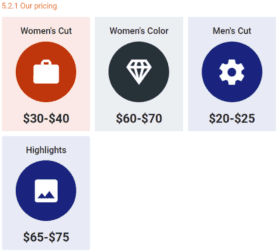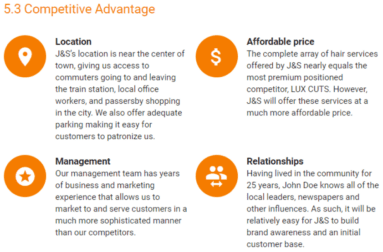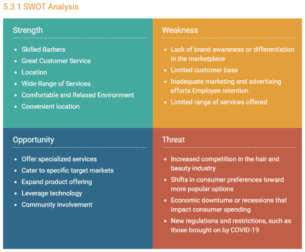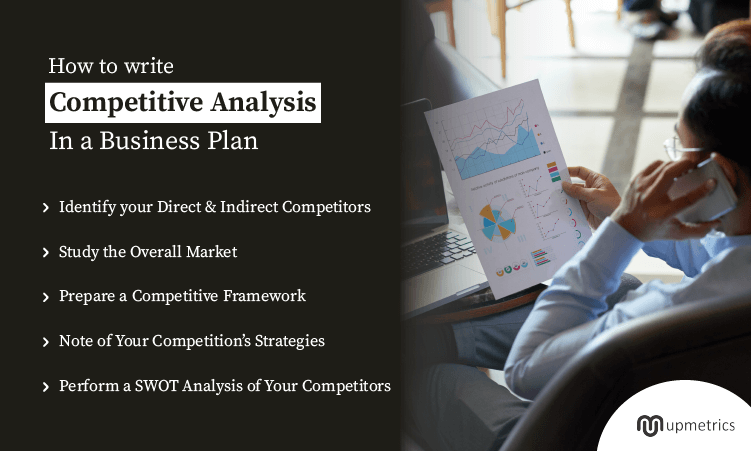Every business wants to outperform its competitors, but do you know the right approach to gather information and analyze your competitors?
That’s where competitive analysis steps in. It’s the tool that helps you know your competition’s pricing strategies, strengths, product details, marketing strategies, target audience, and more.
If you want to know more about competitor analysis, this guide is all you need. It spills all the details on how to conduct and write a competitor analysis in a business plan, with examples.
Let’s get started and first understand the meaning of competitive analysis.
What is Competitive Analysis?
A competitive analysis involves collecting information about what other businesses in your industry are doing with their products, sales, and marketing.
Businesses use this data to find out what they are good at, where they can do better, and what opportunities they might have. It is like checking out the competition to see how and where you can improve.
This kind of analysis helps you get a clear picture of the market, allowing you to make smart decisions to make your business stand out and do well in the industry.
Competitive analysis is a section of utmost value for your business plan. The analysis in this section will form the basis upon which you will frame your marketing, sales, and product-related strategies. So make sure it’s thorough, insightful, and in line with your strategic objectives.
Let’s now understand how you can conduct a competitive analysis for your own business and leverage all its varied benefits.
How to Conduct a Competitive Analysis
Let’s break down the process of conducting a competitive analysis for your business plan in these easy-to-follow steps.
It will help you prepare a solid competitor analysis section in your business plan that actually highlights your strengths and opens room for better discussions (and funding).
Let’s begin.
1. Identify Your Direct and Indirect Competitors
First things first — identify all your business competitors and list them down. You can have a final, detailed list later, but right now an elementary list that mentions your primary competitors (the ones you know and are actively competing with) can suffice.
As you conduct more research, you can keep adding to it.
Explore your competitors using Google, social media platforms, or local markets. Then differentiate them into direct or indirect competitors.
Direct competitors
Businesses offering the same products or services, and targeting a similar target market are your direct competitors.
These competitors operate in the same industry and are often competing for the same market share.
Indirect competitors
On the other hand, indirect competitors are businesses that offer different products or services but cater to the same target customers as yours.
While they may not offer identical solutions, they compete for the same customer budget or attention. Indirect competitors can pose a threat by providing alternatives that customers might consider instead of your offerings.
2. Study the Overall Market
Now that you know your business competitors, deep dive into market research. Market research should involve a combination of both primary and secondary research methods.
Primary research
Primary research involves collecting market information directly from the source or subjects. Some examples of primary market research methods include:
- Purchasing competitors’ products or services
- Conducting interviews with their customers
- Administering online surveys to gather customer insights
Secondary research
Secondary research involves utilizing pre-existing gathered information from some relevant sources. Some of its examples include:
- Scrutinizing competitors’ websites
- Assessing the current economic landscape
- Referring to online market databases of the competitors.
Have a good understanding of the market at this point to write your market analysis section effectively.
3. Prepare a Competitive Framework
Now that you have a thorough understanding of your competitors’ market, it is time to create a competitive framework that enables comparison between two businesses.
Factors like market share, product offering, pricing, distribution channel, target markets, marketing strategies, and customer service offer essential metrics and information to chart your competitive framework.
These factors will form the basis of comparison for your competitive analysis. Depending on the type of your business, choose the factors that are relevant to you.
4. Take Note of Your Competitor’s Strategies
Now that you have an established framework, use that as a base to analyze your competitor’s strategies. Such analysis will help you understand what the customers like and dislike about your competitors.
Start by analyzing the marketing strategies, sales and marketing channels, promotional activities, and branding strategies of your competitors. Understand how they position themselves in the market and what USPs they emphasize.
Evaluate, analyze their pricing strategies and keep an eye on their distribution channel to understand your competitor’s business model in detail.
This information allows you to make informed decisions about your strategies, helping you identify opportunities for differentiation and improvement.
5. Perform a SWOT Analysis of Your Competitors
A SWOT analysis is a method of analyzing the strengths, weaknesses, opportunities, and threats of your business in the competitive marketplace.
While strengths and weaknesses focus on internal aspects of your company, opportunities and threats examine the external factors related to the industry and market.
It’s an important tool that will help determine the company’s competitive edge quite efficiently.
Strengths
It includes the positive features of your internal business operations. For example, a strong brand, skilled workforce, innovative products/services, or a loyal customer base.
Weaknesses
It includes all the hindrances of your internal business operations. For example, limited resources, outdated technology, weak brand recognition, or inefficient processes.
Opportunities
It outlines several opportunities that will come your way in the near or far future. Opportunities can arise as the industry or market trend changes or by leveraging the weaknesses of your competitors.
For example, details about emerging markets, technological advancements, changing consumer trends, profitable partnerships in the future, etc.
Threats
Threats define any external factor that poses a challenge or any risk for your business in this section. For example, intense competition, economic downturns, regulatory changes, or any advanced technology disruption.
This section will form the basis for your business strategies and product offerings. So make sure it’s detailed and offers the right representation of your business.
And that is all you need to create a comprehensive competitive analysis for your business plan.

Want to Perform Competitive Analysis for your Business?
Discover your competition’s secrets effortlessly with our user-friendly and Free Competitor Analysis Generator!
How to Write Competitive Analysis in a Business Plan
The section on competitor analysis is the most crucial part of your business plan. Making this section informative and engaging gets easier when you have all the essential data to form this section.
Now, let’s learn an effective way of writing your competitive analysis.
1. Determine who your readers are
Know your audience first, because that will change the whole context of your competitor analysis business plan.
The competitive analysis section will vary depending on the intended audience is the team or investors.
Consider the following things about your audience before you start writing this section:
Internal competitor plan (employees or partners)
Objective: The internal competitor plan is to provide your team with an understanding of the competitive landscape.
Focus: The focus should be on the comparison of the strengths and weaknesses of competitors to boost strategic discussions within your team.
Use: It is to leverage the above information to develop strategies that highlight your strengths and address your weaknesses.
Competitor plan for funding (bank or investors)
Objective: Here, the objective is to reassure the potential and viability of your business to investors or lenders.
Focus: This section should focus on awareness and deep understanding of the competitive landscape to persuade the readers about the future of your business.
Use: It is to showcase your market position and the opportunities that are on the way to your business.
This differentiation is solely to ensure that the competitive analysis serves its purpose effectively based on the specific needs and expectations of the respective audience.
2. Describe and Visualise Competitive Advantage
Remember how we determined our competitive advantage at the time of research. It is now time to present that advantage in your competitive analysis.
Highlight your edge over other market players in terms of innovation, product quality, features, pricing, or marketing strategy. Understanding your products’ competitive advantage will also help you write the products and services section effectively.
However, don’t limit the edge to your service and market segment. Highlight every area where you excel even if it is better customer service or enhanced brand reputation.
Now, you can explain your analysis through textual blocks. However, a more effective method would be using a positioning map or competitive matrix to offer a visual representation of your company’s competitive advantage.
3. Explain your strategies
Your competitor analysis section should not only highlight the opportunities or threats of your business. It should also mention the strategies you will implement to overcome those threats or capitalize on the opportunities.
Such strategies may include crafting top-notch quality for your products or services, exploring the unexplored market segment, or having creative marketing strategies.
Elaborate on these strategies later in their respective business plan sections.
4. Know the pricing strategy
To understand the pricing strategy of your competitors, there are various aspects you need to have information about. It involves knowing their pricing model, evaluating their price points, and considering the additional costs, if any.
One way to understand this in a better way is to compare features and value offered at different price points and identify the gaps in competitors’ offerings.
Once you know the pricing structure of your competitors, compare it with yours and get to know the competitive advantage of your business from a pricing point of view.
Let us now get a more practical insight by checking an example of competitive analysis.
Competitive Analysis Example in a Business Plan
Here’s a business plan example highlighting the barber shop’s competitive analysis.
1. List of competitors
Direct & Indirect Competitors
The following retailers are located within a 5-mile radius of J&S, thus providing either direct or indirect competition for customers:
Joe’s Beauty Salon
Joe’s Beauty Salon is the town’s most popular beauty salon and has been in business for 32 years. Joe’s offers a wide array of services that you would expect from a beauty salon.
Besides offering haircuts, Joe’s also offers nail services such as manicures and pedicures. In fact, over 60% of Joe’s revenue comes from services targeted at women outside of hair services. In addition, Joe’s does not offer its customers premium salon products.
For example, they only offer 2 types of regular hair gels and 4 types of shampoos. This puts Joe’s in direct competition with the local pharmacy and grocery stores that also carry these mainstream products. J&S, on the other hand, offers numerous options for exclusive products that are not yet available in West Palm Beach, Florida.
LUX CUTS
LUX CUTS has been in business for 5 years. LUX CUTS offers an extremely high-end hair service, with introductory prices of $120 per haircut.
However, LUX CUTS will primarily be targeting a different customer segment from J&S, focusing on households with an income in the top 10% of the city.
Furthermore, J&S offers many of the services and products that LUX CUTS offers, but at a fraction of the price, such as:
- Hairstyle suggestions & hair care consultation
- Hair extensions & coloring
- Premium hair products from industry leaders
Freddie’s Fast Hair Salon
Freddie’s Fast Hair Salon is located four stores down the road from J&S. Freddy’s has been in business for the past 3 years and enjoys great success, primarily due to its prime location.
Freddy’s business offers inexpensive haircuts and focuses on volume over quality. It also has a large customer base comprised of children between the ages of 5 to 13.
J&S has several advantages over Freddy’s Fast Hair Salon including:
- An entertainment-focused waiting room, with TVs and board games to make the wait for service more pleasurable. Especially great for parents who bring their children.
- A focus on service quality rather than speed alone to ensure repeat visits. J&S will spend on average 20 more minutes with its clients than Freddy’s.
While we expect that Freddy’s Fast Hair Salon will continue to thrive based on its location and customer relationships, we expect that more and more customers will frequent J&S based on the high-quality service it provides.
2. Competitive Pricing
John and Sons Barbing Salon will work towards ensuring that all our services are offered at highly competitive prices compared to what is obtainable in The United States of America.
We know the importance of gaining entrance into the market by lowering our pricing to attract all and sundry that is why we have consulted with experts and they have given us the best insights on how to do this and effectively gain more clients soon.
Our pricing system is going to be based on what is obtainable in the industry, we don’t intend to charge more (except for premium and customized services) and we don’t intend to charge less than our competitors are offering in West Palm Beach – Florida.

3. Our pricing

Payment options:
At John & Sons Barbing Salon, our payment policy is all-inclusive because we are quite aware that different people prefer different payment options as they suit them. Here are the payment options that will be available in all our outlets;
- Payment by cash
- Payment via Point of Sale (POS) Machine
- Payment via online bank transfer (online payment portal)
- Payment via Mobile money
- Check (only from loyal customers)
Given the above, we have chosen banking platforms that will help us achieve our payment plans without any itches.
4. Competitive advantage

5. SWOT analysis

Why is a Competitive Environment helpful?
Somewhere we all think, “What if we had no competition?” “What if we were the monopoly?” It would be great, right? Well, this is not the reality, and have to accept the competition sooner or later.
However, competition is healthy for businesses to thrive and survive, let’s see how:
1. Competition Validates your Idea
When people are developing similar products like you, it is a sign that you are on the right path. Having healthy competition proves that your idea is valid and there is a potential target market for your product and service offerings.
2. Innovation and Efficiency
Businesses competing with each other are motivated to innovate consistently, thereby, increasing their scope and market of product offerings. Moreover, when you are operating in a cutthroat environment, you simply cannot afford to be inefficient.
Be it in terms of costs, production, pricing, or marketing—you will ensure efficiency in all aspects to attract more business.
3. Market Responsiveness
Companies in a competitive environment tend to stay relevant and longer in business since they are adaptive to the changing environment. In the absence of competition, you would start getting redundant which will throw you out of the market, sooner or later.
4. Eases Consumer Education
Since your target market is already aware of the problem and existing market solutions, it would be much easier to introduce your business to them. Rather than focusing on educating, you would be more focused on branding and positioning your brand as an ideal customer solution.
Being the first one in the market is exciting. However, having healthy competition has these proven advantages which are hard to ignore.
A way forward
Whether you are starting a new business or have an already established unit, having a practical and realistic understanding of your competitive landscape is essential to developing efficient business strategies.
While getting to know your competition is essential, don’t get too hung up in the research. Research your competitors to improve your business plan and strategies, not to copy their ideas.
Create your unique strategies, offer the best possible services, and add value to your offerings—that will make you stand out.
While it’s a long, tough road, a comprehensive business plan can be your guide. Using modern business planning software is probably the easiest way to draft your plan.
Use Upmetrics. Simply enter your business details, answer the strategic questions, and see your business plan come together in front of your eyes.




